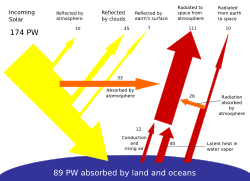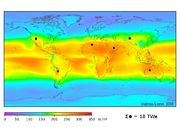 |
|
| Solar Technologies |
 |
|
 |
| Upcoming Seminars |
 |
|
| |
|
|
 |
What is Solar? |
Solar Energy |
|
| Energy from the Sun |
| |
 |
 |
| About half the incoming solar energy reaches the earth's surface. |
|
| Main articles: Insolation and Solar radiation |
| |
| The Earth receives 174 petawatts (PW) of incoming solar radiation (insolation) at the upper atmosphere.[1] Approximately 30% is reflected back to space while the rest is absorbed by clouds, oceans and land masses. The spectrum of solar light at the Earth's surface is mostly spread across the visible and near-infrared ranges with a small part in the near-ultraviolet.[2] |
| |
| The absorbed solar light heats the land surface, oceans and
atmosphere. The warm air containing evaporated water from the oceans
rises, driving atmospheric circulation or convection.
When this air reaches a high altitude, where the temperature is low,
water vapor condenses into clouds, which rain onto the earth's surface,
completing the water cycle. The latent heat of water condensation amplifies convection, producing atmospheric phenomena such as cyclones and anti-cyclones. Wind is a |
| manifestation of the atmospheric circulation driven by solar energy.[3] Sunlight absorbed by the oceans and land masses keeps the surface at an average temperature of 14 °C.[4] The conversion of solar energy into chemical energy via photosynthesis produces food, wood and the biomass from which fossil fuels are derived.[5] |
|
| |
| Solar energy absorbed by atmosphere, oceans and Earth[6] |
751,296,000.0 |
| Wind energy (technical potential) [7] |
221,000.0 |
| Electricity (2005) [8] |
-45.2 |
| Primary energy use (2005) [9] |
-369.7 |
|
| |
| Solar radiation along with secondary solar resources such as wind and wave power, hydroelectricity and biomass account for 99.97% of the available renewable energy on Earth.[10][11] |
| |
| The total solar energy absorbed by Earth's atmosphere, oceans and land masses is approximately 3,850 zettajoules (ZJ) per year.[12] In 2002, this was more energy in one hour than the world used in one year.[13][14] Photosynthesis captures approximately 3 ZJ per year in biomass.[15] The amount of solar energy reaching the surface of the planet is so
vast that in one year it is about twice as much as will ever be
obtained from all of the Earth's non-renewable resources of coal, oil,
natural gas, and mined uranium combined.[16] |
| |
| From the table of resources it would appear that solar, wind or
biomass would be sufficient to supply all of our energy needs, however,
the increased use of biomass has had a negative effect on global warming and dramatically increased food prices by diverting forests and crops into biofuel production.[17] As intermittent resources, solar and wind raise other issues. |
| |
| Applications of solar technology |
| |
 |
 |
| Average insolation showing land area (small black dots) required to replace the total
world energy supply with solar electricity. Insolation for most people
is from 150 to 300 W/m^2 or 3.5 to 7.0 kWh/m^2/day. |
|
| Solar energy refers primarily to the use of solar radiation for practical ends. All other renewable energies other than geothermal derive their energy from energy received from the sun. |
| |
| Solar technologies are broadly characterized as either passive or
active depending on the way they capture, convert and distribute
sunlight. Active solar techniques use photovoltaic panels, pumps, and
fans to convert sunlight into useful outputs. Passive solar techniques
include selecting materials with favorable thermal properties,
designing spaces that naturally circulate air, and referencing the
position of a building to the Sun. Active solar technologies increase
the supply of energy and are considered supply side technologies, while passive solar technologies reduce the need for
alternate resources and are generally considered demand side
technologies.[18] |
| |
| |
| |
| |
| |
| |
|
|
| |
|
|